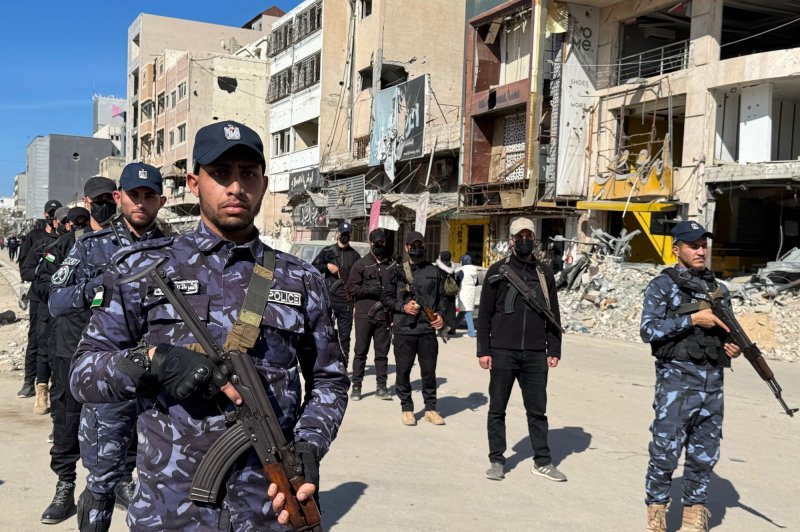Hamas police officers deploy on the streets of Gaza to maintain order after a cease-fire and hostage release deal with Israel came into effect. The group, designated a terror organization by the United States and most Western countries, said it would name on Friday the next group of hostages to be set free. File Photo by Ayman Alhesi/UPI. |
License PhotoJan. 24 (UPI) — Prime Minister Benjamin Netanyahu said on Friday that Hamas has violated an agreement on the release of hostages with its publication of those to be released on Saturday.
Netanyahu’s office said Hamas had agreed to release four hostages on Saturday — three soldiers and one civilian. Hamas had also agreed to give the status of 26 remaining hostages held in Gaza as part of the first phase of releases.
Following the release of the names, which media were instructed not to publish until the hostages’ families were notified, Netanyahu huddled with his security chiefs and decided to proceed with the list despite the violation.
Israel, in exchange, was expected to release security prisoners along with its withdrawal from some areas of Gaza. Israeli officials called on media outlets not to post the names of those released by Hamas until their families were notified.
Israeli civilian hostages Emily Damari, Romi Gonen and Doron Steinbrecher were released by Hamas on Sunday.
Istanbul-based senior Hamas leader Zaher Jabarin was reported to have told Qatari media the names of the second group of four hostages would be passed to mediators, ahead of the second exchange, which is scheduled for Saturday afternoon.
The hostages — all women — are believed to be either civilians or military personnel who will be swapped for 180 Palestinians held in prisons in Israel.
Israel had said it wants 29-year-old Arbel Yehud to be among them but fears Hamas may stall because she is being held by Islamic Jihad, a different group.
Israeli security officials were also said to be lowering their expectations that Hamas would be forthcoming with the names and status of 26 hostages still slated for release during the initial six-week phase of the deal that came into effect Sunday.
They now believe the best they can hope for is to be notified how many of the 26 are still alive.
Israel has insisted that none of the prisoners being set free Saturday were involved in the Oct. 7 attack on southern Israel by Hamas and other militant Palestinian groups in which 1,200 people were killed and 251 were abducted and taken back Gaza, but acknowledged they were in a “more serious category” than those freed Monday in the first swap.
Included will be prisoners serving sentences of 15 years and more and those who have killed people.
So far, 120 of the hostages have been set free either in a week-long truce in November 2023 or in rescue missions by Israeli special forces. Israel believes 57 of the 91 hostages still being held are alive, along with two of three historic hostages who have been in captivity for 10 years or longer.
The cease-fire announced Jan. 15 by U.S. President Joe Biden in Washington and Qatari Prime Minister Mohammed bin Abdulrahman Al Thani in Doha, has three phases aimed at halting the fighting, the return of all hostages and an eventual permanent end to the 15-month bloody conflict.
In addition to the cease-fire and hostage/prisoner releases, stage one also calls for Israeli forces in Gaza to pull out of populated areas apart from buffer zones in border areas, including the southern Philadelphi Corridor between Rafah and Egypt, allow displaced civilians to return to their homes and allow in hundreds of trucks carrying humanitarian supplies each day.
Negotiations on the second phase involving making the cease-fire permanent and the full withdrawal of Israeli forces from Gaza are scheduled to get underway Feb. 4.
The third phase, if it ever materializes, aims to see the bodies of all deceased hostages handed back and the reconstruction of Gaza which is expected to take years and only be possible with a political settlement of some sort.
